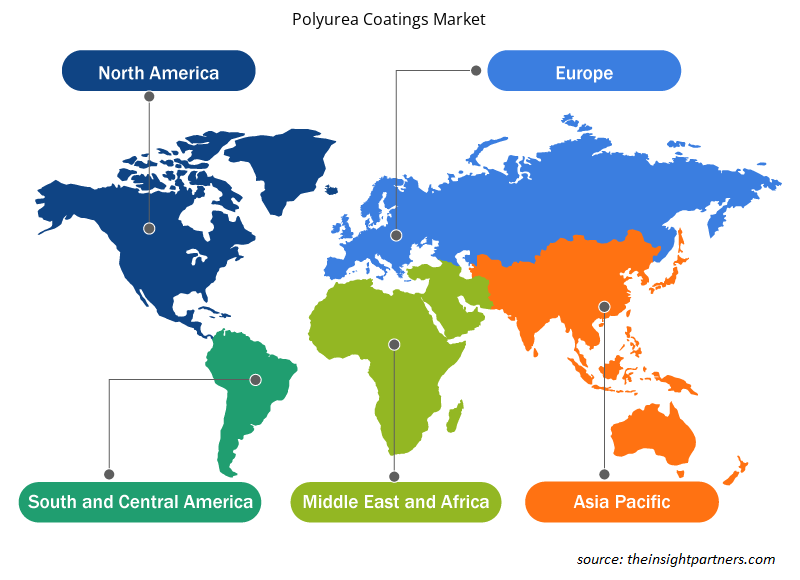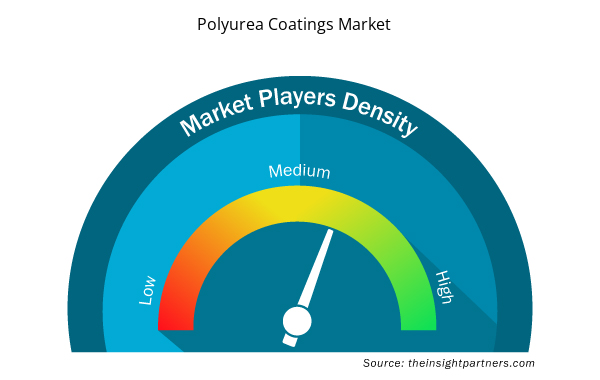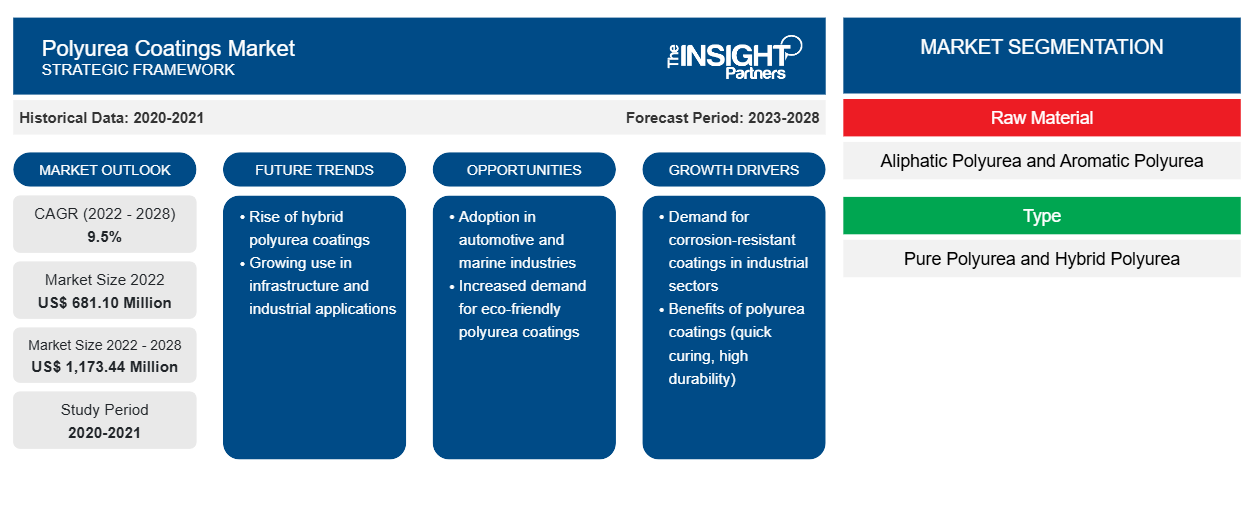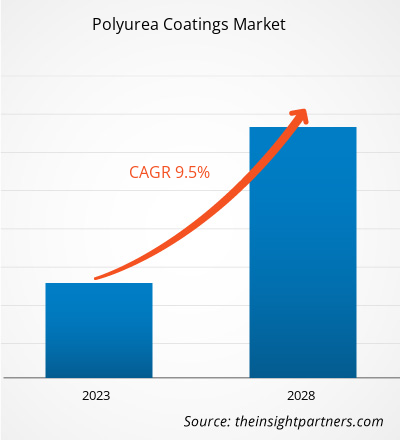Der Markt für Polyharnstoffbeschichtungen soll von 681,10 Millionen US-Dollar im Jahr 2022 auf 1.173,44 Millionen US-Dollar im Jahr 2028 wachsen; für den Zeitraum von 2022 bis 2028 wird eine durchschnittliche jährliche Wachstumsrate (CAGR) von 9,5 % erwartet.
Polyharnstoff ist ein wasserfestes Material, das häufig in industriellen und gewerblichen Umgebungen verwendet wird, um Oberflächen vor Wasserschäden zu schützen. Es wird als flüssige Beschichtung aufgetragen, die dann schnell aushärtet und eine dauerhafte, wasserdichte Barriere bildet. Es kann zum Abdichten von Dächern, Fundamenten, Decks und anderen Oberflächen verwendet werden.
Im Jahr 2022 hatte Nordamerika den größten Anteil am globalen Markt für Polyharnstoffbeschichtungen . Der nordamerikanische Markt für Polyharnstoffbeschichtungen ist nach Ländern in die USA, Kanada und Mexiko unterteilt. Die Bauindustrie trägt einen großen Teil zum BIP der Region bei. Die Industrie unterstützt das Wirtschaftswachstum, indem sie die Lieferkette unterstützt, was zahlreiche Geschäftsmöglichkeiten und Dienstleistungen schafft. Der Bausektor Nordamerikas ist eine entscheidende Industrie, da er in der Region Millionen von Menschen beschäftigt. Das schnelle Wachstum der Bautätigkeit in Nordamerika erhöht die Nachfrage nach Polyharnstoffbeschichtungen.
Passen Sie diesen Bericht Ihren Anforderungen an
Sie erhalten kostenlos individuelle Anpassungen an jedem Bericht, einschließlich Teilen dieses Berichts oder einer Analyse auf Länderebene, eines Excel-Datenpakets sowie tolle Angebote und Rabatte für Start-ups und Universitäten.
- Holen Sie sich die wichtigsten Markttrends aus diesem Bericht.Dieses KOSTENLOSE Beispiel umfasst eine Datenanalyse von Markttrends bis hin zu Schätzungen und Prognosen.
Auswirkungen der COVID-19-Pandemie auf den Markt für Polyharnstoffbeschichtungen
Vor dem Ausbruch der COVID-19-Pandemie wurde der Markt für Polyharnstoffbeschichtungen hauptsächlich durch ihre zunehmende Verwendung im Wohn- und Nichtwohnbau vorangetrieben. Der Ausbruch der Pandemie bremste jedoch das Wachstum des Chemie- und Materialsektors und bremste damit das Wachstum des Marktes für Polyharnstoffbeschichtungen. Die Umsetzung von Maßnahmen zur Bekämpfung der Ausbreitung von SARS-CoV-2 wirkte sich negativ auf das Wachstum verschiedener Branchen aus. Aufgrund der langfristigen Schließung vieler Fabriken kam es für Bauunternehmen zu Verzögerungen und höheren Kosten für importierte Rohstoffe und Baumaterialien außerhalb der Baustelle. Der durch die Auswirkungen der Pandemie auf die Baubranche verursachte Schaden bremste die Nachfrage nach Polyharnstoffbeschichtungen.
Der globale Markt erholt sich von den Verlusten, die durch die COVID-19-Pandemie entstanden sind, da Regierungen verschiedener Länder Lockerungen der Beschränkungen angekündigt haben. Hersteller dürfen mit voller Kapazität arbeiten, was ihnen hilft, die Lücke zwischen Angebot und Nachfrage zu schließen. Dies dürfte sich in den kommenden Jahren positiv auf das Wachstum des Marktes für Polyharnstoffbeschichtungen auswirken.
Markteinblicke
Schnelles Wachstum im Bau- und Infrastruktursektor treibt das Wachstum des Polyharnstoffmarktes an
Die Nachfrage nach Polyharnstoffbeschichtungen ist mit der Zunahme der Bautätigkeit gestiegen. Mit der steigenden Bevölkerung und der wachsenden Immobilienbranche ist auch der Bedarf an Polyharnstoffbeschichtungen gestiegen. Polyharnstoff ist ein wasserdichtes Material, das häufig in industriellen und gewerblichen Umgebungen verwendet wird, um Oberflächen vor Wasserschäden zu schützen. Es wird als flüssige Beschichtung aufgetragen, die dann schnell aushärtet und eine dauerhafte, wasserdichte Barriere bildet. Diese kann zum Abdichten von Dächern, Fundamenten, Decks und anderen Oberflächen verwendet werden.
Die rasante Bautätigkeit hat den Bedarf an Polyharnstoffbeschichtungen in verschiedenen Materialien und Formen erhöht. Steigende Staatsausgaben und Investitionen zur Verbesserung der inländischen Infrastruktur und zur Aufrechterhaltung des Wirtschaftswachstums sowie die steigende Nachfrage nach diesen Beschichtungen in der Bauindustrie, insbesondere in Entwicklungsländern, sind einige der Hauptfaktoren, die das Wachstum des Marktes für Polyharnstoffbeschichtungen vorantreiben.
Typbasierte Erkenntnisse
Der globale Markt für Polyharnstoffbeschichtungen ist nach Typ in reines Polyharnstoff und Hybrid-Polyharnstoff unterteilt. Eine reine Polyharnstoffbeschichtung wird aus dem Reaktionsprodukt einer Polyisocyanatkomponente und einer aminterminierten Harzmischung gewonnen. Reines Polyharnstoff ist eine Kombination aus Isocyanat und Polyamin. Diese Molekülstruktur ist völlig unempfindlich gegenüber Feuchtigkeit. Reines Polyharnstoff reagiert nicht mit Wasser und ist daher das beste wasserdichte Material. Eine reine Polyharnstoffbeschichtung ist eine Art Urethan, das typischerweise für Außen- oder Industrieanwendungen wie Gartenmöbel , Schilder und Gebäudefassaden verwendet wird. Im Vergleich zu herkömmlichen Systemen wie Epoxidfarben bietet eine reine Polyharnstoffbeschichtung geringere Wartungskosten und eine höhere Haltbarkeit.
BASF SE; PPG Industries, Inc; Sika AG; Fosroc, Inc; The Sherwin – Williams Company; VIP Coatings International Gmbh; Nukote Coating Systems International; Huntsman International LLC; Rhino Linings Corporation; und Teknos Group gehören zu den wichtigsten Akteuren auf dem globalen Markt für Polyharnstoffbeschichtungen. Die Akteure auf dem Markt konzentrieren sich darauf, qualitativ hochwertige Produkte anzubieten, um die Kundennachfrage zu erfüllen. Sie verfolgen auch Strategien wie Investitionen in Forschung und Entwicklung, die Einführung neuer Produkte und die Ausweitung der Produktionskapazitäten.
Bericht-Spotlights
- Fortschrittliche Branchentrends auf dem Markt für Polyharnstoffbeschichtungen helfen den Akteuren bei der Entwicklung wirksamer langfristiger Strategien
- In Industrie- und Entwicklungsländern angewandte Strategien für Unternehmenswachstum
- Quantitative Analyse des Marktes für Polyharnstoffbeschichtungen von 2020 bis 2028
- Schätzung der weltweiten Nachfrage nach Polyharnstoffbeschichtungen
- Porters Fünf-Kräfte-Analyse zur Veranschaulichung der Wirksamkeit der in der Branche tätigen Käufer und Lieferanten
- Aktuelle Entwicklungen zum Verständnis des wettbewerbsorientierten Marktszenarios
- Markttrends und -aussichten sowie Faktoren, die das Wachstum des Marktes für Polyharnstoffbeschichtungen vorantreiben und bremsen
- Unterstützung im Entscheidungsprozess durch Aufzeigen von Marktstrategien, die das kommerzielle Interesse untermauern und zum Marktwachstum führen
- Die Marktgröße für Polyharnstoffbeschichtungen an verschiedenen Knotenpunkten
- Detaillierte Übersicht und Segmentierung des Marktes sowie der Dynamik der Polyharnstoffbeschichtungsindustrie
- Die Marktgröße von Polyharnstoffbeschichtungen in verschiedenen Regionen mit vielversprechenden Wachstumschancen
Regionale Einblicke in den Markt für Polyharnstoffbeschichtungen
Die regionalen Trends und Faktoren, die den Markt für Polyharnstoffbeschichtungen im Prognosezeitraum beeinflussen, wurden von den Analysten von Insight Partners ausführlich erläutert. In diesem Abschnitt werden auch die Marktsegmente und die Geografie von Polyharnstoffbeschichtungen in Nordamerika, Europa, im asiatisch-pazifischen Raum, im Nahen Osten und Afrika sowie in Süd- und Mittelamerika erörtert.

- Erhalten Sie regionale Daten zum Markt für Polyharnstoffbeschichtungen
Umfang des Marktberichts zu Polyharnstoffbeschichtungen
| Berichtsattribut | Details |
|---|---|
| Marktgröße im Jahr 2022 | 681,10 Millionen US-Dollar |
| Marktgröße bis 2028 | 1.173,44 Millionen US-Dollar |
| Globale CAGR (2022 - 2028) | 9,5 % |
| Historische Daten | 2020-2021 |
| Prognosezeitraum | 2023–2028 |
| Abgedeckte Segmente | Nach Rohmaterial
|
| Abgedeckte Regionen und Länder | Nordamerika
|
| Marktführer und wichtige Unternehmensprofile |
|
Marktteilnehmerdichte für Polyharnstoffbeschichtungen: Auswirkungen auf die Geschäftsdynamik verstehen
Der Markt für Polyharnstoffbeschichtungen wächst rasant, angetrieben durch die steigende Nachfrage der Endverbraucher aufgrund von Faktoren wie sich entwickelnden Verbraucherpräferenzen, technologischen Fortschritten und einem größeren Bewusstsein für die Vorteile des Produkts. Mit steigender Nachfrage erweitern Unternehmen ihr Angebot, entwickeln Innovationen, um die Bedürfnisse der Verbraucher zu erfüllen, und nutzen neue Trends, was das Marktwachstum weiter ankurbelt.
Die Marktteilnehmerdichte bezieht sich auf die Verteilung der Firmen oder Unternehmen, die in einem bestimmten Markt oder einer bestimmten Branche tätig sind. Sie gibt an, wie viele Wettbewerber (Marktteilnehmer) in einem bestimmten Marktraum im Verhältnis zu seiner Größe oder seinem gesamten Marktwert präsent sind.
Die wichtigsten auf dem Markt für Polyharnstoffbeschichtungen tätigen Unternehmen sind:
- BASF SE
- PPG Industries Inc
- Sika AG
- Fosroc Inc
- Die Sherwin-Williams Co
Haftungsausschluss : Die oben aufgeführten Unternehmen sind nicht in einer bestimmten Reihenfolge aufgeführt.

- Überblick über die wichtigsten Akteure auf dem Markt für Polyharnstoffbeschichtungen
Globaler Markt für Polyharnstoffbeschichtungen
Basierend auf dem Rohstoff ist der Markt in aliphatisches Polyharnstoff und aromatisches Polyharnstoff unterteilt. Basierend auf dem Typ ist der globale Markt für Polyharnstoffbeschichtungen in reines Polyharnstoff und Hybrid-Polyharnstoff unterteilt. Basierend auf der Technologie ist der Markt in Sprühen, Gießen und Handmischen unterteilt. Basierend auf der Anwendung ist der globale Markt für Polyharnstoffbeschichtungen in Bauwesen, Transport, industrielle Anwendung und andere unterteilt.
Firmenprofile
- BASF SE
- PPG Industries, Inc
- Sika AG
- Fosroc, Inc
- Die Sherwin-Williams Company
- VIP Coatings International GmbH
- Nukote Coating Systems International
- Huntsman International LLC
- Rhino Linings Corporation
- Teknos-Gruppe
- Historische Analyse (2 Jahre), Basisjahr, Prognose (7 Jahre) mit CAGR
- PEST- und SWOT-Analyse
- Marktgröße Wert/Volumen – Global, Regional, Land
- Branche und Wettbewerbsumfeld
- Excel-Datensatz


- Electronic Health Record Market
- Industrial Inkjet Printers Market
- Adaptive Traffic Control System Market
- Small Molecule Drug Discovery Market
- Drain Cleaning Equipment Market
- Greens Powder Market
- Hand Sanitizer Market
- Electronic Signature Software Market
- Visualization and 3D Rendering Software Market
- Helicopters Market

Report Coverage
Revenue forecast, Company Analysis, Industry landscape, Growth factors, and Trends

Segment Covered
This text is related
to segments covered.

Regional Scope
North America, Europe, Asia Pacific, Middle East & Africa, South & Central America

Country Scope
This text is related
to country scope.
Häufig gestellte Fragen
The increase in building and construction activities, and the superiority of polyurea coatings over epoxy coatings are some of the key driving factors for the polyurea coatings market.
Based on application, industrial application is the fastest-growing segment. In industrial sectors such as steel structures, concrete walls, or outdoor furniture, pure polyurea’s are often combined with other materials to create a hybrid coating that can be applied in roadway construction and bridge decks. Thus, wide range of applications is driving the segment’s growth.
North America polyurea coatings market is expected to surge due to the growing product penetration in residential construction for flooring and roofing applications. Furthermore, the rising building and construction activities in the corporate and residential sectors are surging the demand for polyurea coatings in the region. Therefore, North America accounts for the largest share of the global polyurea coatings market.
The advancement in infrastructure activities in the emerging economies, is expected to provide lucrative growth opportunities to the global polyurea coatings market during the forecast period.
Hybrid polyurea coatings are a type of coating that can be applied to concrete surfaces. They come with many benefits, like being resistant to abrasion, corrosion, and chemical attack. Therefore, this factor is expected to boost the hybrid polyurea segment, leading to largest revenue share.
The major players operating in the global polyurea coatings market are BASF SE; PPG Industries Inc; Sika AG; The Sherwin-Williams Co; Huntsman International LLC; amongst others.
Trends and growth analysis reports related to Chemicals and Materials : READ MORE..
The List of Companies - Polyurea Coatings Market
- BASF SE
- PPG Industries Inc
- Sika AG
- Fosroc Inc
- The Sherwin-Williams Co
- VIP Coatings International GmbH & Co KG
- Nukote Coating Systems International LLC
- Huntsman International LLC
- Rhino Linings Corp
- Teknos Group Oy
The Insight Partners performs research in 4 major stages: Data Collection & Secondary Research, Primary Research, Data Analysis and Data Triangulation & Final Review.
- Data Collection and Secondary Research:
As a market research and consulting firm operating from a decade, we have published and advised several client across the globe. First step for any study will start with an assessment of currently available data and insights from existing reports. Further, historical and current market information is collected from Investor Presentations, Annual Reports, SEC Filings, etc., and other information related to company’s performance and market positioning are gathered from Paid Databases (Factiva, Hoovers, and Reuters) and various other publications available in public domain.
Several associations trade associates, technical forums, institutes, societies and organization are accessed to gain technical as well as market related insights through their publications such as research papers, blogs and press releases related to the studies are referred to get cues about the market. Further, white papers, journals, magazines, and other news articles published in last 3 years are scrutinized and analyzed to understand the current market trends.
- Primary Research:
The primarily interview analysis comprise of data obtained from industry participants interview and answers to survey questions gathered by in-house primary team.
For primary research, interviews are conducted with industry experts/CEOs/Marketing Managers/VPs/Subject Matter Experts from both demand and supply side to get a 360-degree view of the market. The primary team conducts several interviews based on the complexity of the markets to understand the various market trends and dynamics which makes research more credible and precise.
A typical research interview fulfils the following functions:
- Provides first-hand information on the market size, market trends, growth trends, competitive landscape, and outlook
- Validates and strengthens in-house secondary research findings
- Develops the analysis team’s expertise and market understanding
Primary research involves email interactions and telephone interviews for each market, category, segment, and sub-segment across geographies. The participants who typically take part in such a process include, but are not limited to:
- Industry participants: VPs, business development managers, market intelligence managers and national sales managers
- Outside experts: Valuation experts, research analysts and key opinion leaders specializing in the electronics and semiconductor industry.
Below is the breakup of our primary respondents by company, designation, and region:

Once we receive the confirmation from primary research sources or primary respondents, we finalize the base year market estimation and forecast the data as per the macroeconomic and microeconomic factors assessed during data collection.
- Data Analysis:
Once data is validated through both secondary as well as primary respondents, we finalize the market estimations by hypothesis formulation and factor analysis at regional and country level.
- Macro-Economic Factor Analysis:
We analyse macroeconomic indicators such the gross domestic product (GDP), increase in the demand for goods and services across industries, technological advancement, regional economic growth, governmental policies, the influence of COVID-19, PEST analysis, and other aspects. This analysis aids in setting benchmarks for various nations/regions and approximating market splits. Additionally, the general trend of the aforementioned components aid in determining the market's development possibilities.
- Country Level Data:
Various factors that are especially aligned to the country are taken into account to determine the market size for a certain area and country, including the presence of vendors, such as headquarters and offices, the country's GDP, demand patterns, and industry growth. To comprehend the market dynamics for the nation, a number of growth variables, inhibitors, application areas, and current market trends are researched. The aforementioned elements aid in determining the country's overall market's growth potential.
- Company Profile:
The “Table of Contents” is formulated by listing and analyzing more than 25 - 30 companies operating in the market ecosystem across geographies. However, we profile only 10 companies as a standard practice in our syndicate reports. These 10 companies comprise leading, emerging, and regional players. Nonetheless, our analysis is not restricted to the 10 listed companies, we also analyze other companies present in the market to develop a holistic view and understand the prevailing trends. The “Company Profiles” section in the report covers key facts, business description, products & services, financial information, SWOT analysis, and key developments. The financial information presented is extracted from the annual reports and official documents of the publicly listed companies. Upon collecting the information for the sections of respective companies, we verify them via various primary sources and then compile the data in respective company profiles. The company level information helps us in deriving the base number as well as in forecasting the market size.
- Developing Base Number:
Aggregation of sales statistics (2020-2022) and macro-economic factor, and other secondary and primary research insights are utilized to arrive at base number and related market shares for 2022. The data gaps are identified in this step and relevant market data is analyzed, collected from paid primary interviews or databases. On finalizing the base year market size, forecasts are developed on the basis of macro-economic, industry and market growth factors and company level analysis.
- Data Triangulation and Final Review:
The market findings and base year market size calculations are validated from supply as well as demand side. Demand side validations are based on macro-economic factor analysis and benchmarks for respective regions and countries. In case of supply side validations, revenues of major companies are estimated (in case not available) based on industry benchmark, approximate number of employees, product portfolio, and primary interviews revenues are gathered. Further revenue from target product/service segment is assessed to avoid overshooting of market statistics. In case of heavy deviations between supply and demand side values, all thes steps are repeated to achieve synchronization.
We follow an iterative model, wherein we share our research findings with Subject Matter Experts (SME’s) and Key Opinion Leaders (KOLs) until consensus view of the market is not formulated – this model negates any drastic deviation in the opinions of experts. Only validated and universally acceptable research findings are quoted in our reports.
We have important check points that we use to validate our research findings – which we call – data triangulation, where we validate the information, we generate from secondary sources with primary interviews and then we re-validate with our internal data bases and Subject matter experts. This comprehensive model enables us to deliver high quality, reliable data in shortest possible time.


 Holen Sie sich ein kostenloses Muster für diesen Bericht
Holen Sie sich ein kostenloses Muster für diesen Bericht